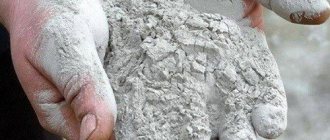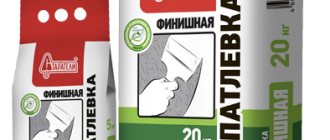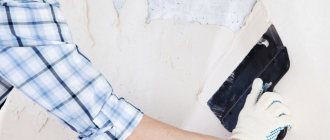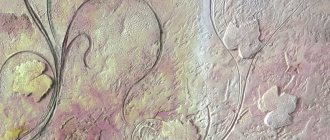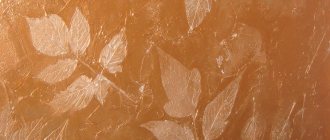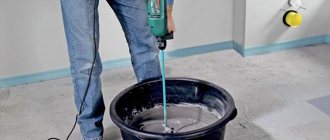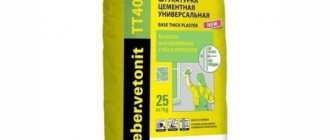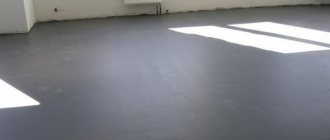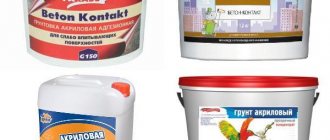Putty is a collective name for building mixtures intended for finishing or pre-finishing leveling of surfaces.
Their range, presented in construction stores, is very diverse, therefore, for the convenience of choosing the right putty solution, they are all divided into several groups according to composition, method and area of application, including basic or starting putty.
Application area
Putties form a finer structure than plasters.
Starting putty, in terms of its purpose and area of use, is somewhere in the middle between plaster and finishing putties. It is used for leveling various rough bases - concrete and brick walls, as well as plastered surfaces.
Unlike plaster, the basic putty composition uses a filler of a finer fraction. This allows you to obtain a finer surface structure after treatment than after plastering.
To ensure that the putty surface lasts as long as possible, it is recommended to use mixtures from the same manufacturer for plastering and puttying. Created using the same technologies using a mutually compatible set of components, they will be able to combine in the best possible way.
The finishing compositions are applied in a thinner layer.
The starting putty differs from the finishing putty in the possibility of applying a thicker layer, but at the same time, the base compositions differ from the finishing ones in having a coarser texture, which does not allow them to be used as a direct base for some finishing materials - paints and varnishes, wallpaper with fine texture, etc.
Unlike finishing types, starting mixtures can be applied in several stages, obtaining fairly thick layers up to 1.5 - 2 cm.
Using basic putty, you can repair minor defects in load-bearing surfaces: small deviations of the surface from the vertical or horizontal level, cracks and crevices in the wall, sinks, potholes in concrete and brick.
So, you should pay priority attention to the starting putty if you need:
- after installing the door or window frame, seal the resulting gap between it and the wall opening;
- fill grooves for electrical wiring in concrete and brick walls;
- seal the joints between the wall and floor slabs, as well as between other structures.
What is finishing putty and why is it needed?
By putty we mean a leveling mixture with a solid filler with a fraction of less than 1 mm. The material is supplied to trading platforms in the form of a finished paste or dry powder for mixing with water. The composition is used for the final stage of preparing the surface for subsequent painting or wallpapering.
Types of starting putty compositions
All starting putty compositions are divided into three large groups depending on their composition and into two groups depending on the method of application.
Mixture composition
Polymer putties are the most durable.
By and large, the composition of both base and finishing plasters is largely identical.
They differ only in the size of the filler fractions and the type of binding components. Both solutions are:
- Cement. They use various types of cement as a binder. They have a gray color of varying saturation. Among their distinctive qualities, mention should be made of their high resistance to dampness. But at the same time, when drying, cement compositions shrink strongly, which can lead to cracking if an excessively thick layer is applied. Such mixtures are well suited for finishing building facades, treating walls and ceilings in bathrooms, kitchens, saunas, baths, etc. Using cement mixtures, you can putty door and window slopes.
- Plaster. They are distinguished by their bright white color. They are created on the basis of gypsum, as a result of which they are not sufficiently resistant to moisture. At the same time, gypsum starting putty is elastic and does not shrink when dried. The drying time of the treated surface is much shorter than that of cement compositions.
- Polymer. The most high-tech version of putty
compositions created on the basis of polymer compounds. They can be either white or light gray. They have a long service life, are flexible and easy to use. Among the main disadvantages of polymer mixtures is their high cost compared to cement and gypsum compositions. They are universal in application - they can be used for both external and internal work.
Cement compositions in some cases have a dark gray color, so they can be visible through a thin layer of finishing putty or light paint. If you plan to apply a light-colored finish to the wall, it is better to use gypsum solutions as a base.
Application area
According to their purpose, starting putty compositions can be:
- for outdoor work;
- for interior work.
Facade compositions must withstand atmospheric conditions well.
For external work, special compositions that are resistant to aggressive external influences are used. First of all, they must tolerate high humidity well, which is why they mainly use cement and polymer putty for finishing facades. The same mixtures are also used when working in rooms with difficult operating conditions.
For interior work, you can use any of all types of starting mixtures - cement, gypsum, polymer.
But provided that the room being finished has normal air humidity, not exceeding 65 - 70%. Otherwise, the use of gypsum compositions is contraindicated.
Making your own starting putty
On the modern market of finishing materials there is a huge range of different putty compositions, including basic varieties. However, in some cases large hardware stores may not be available.
For example, when a house located somewhere in the countryside is being renovated. The table below provides recipes for preparing starting putties at home.
| № | Name | Application area | Preparation |
| 1 | Gypsum-chalk | Leveling walls made of concrete and gypsum plasterboard in dry rooms | Mix 1 part plaster and 3 parts chalk in a dry bowl. Gradually, while stirring, pour the mixture into a container with a 5% solution of wood glue and stir until smooth. Use immediately - the solution hardens quickly. |
| 2 | Oily | Wooden surfaces exposed to temperature changes (wooden façade cladding, window frames). | Mix 2 kg of chalk with 1 kg of drying oil, add 0.1 kg of drier and put the mixture on fire. Bring carefully to a boil and cool. Use warm. |
Technique for working with basic putty
Starter putty, like other putty compounds, should be applied to previously prepared substrates. For more information about basic putty, watch this video:
Surface preparation
It is necessary to clean the wall of dirt, dust and previous coatings.
Before applying putty, the surface must be cleaned of dust and other contaminants. You should also remove all loose and crumbling elements in advance. To clean the base, you can use any of the most suitable tools.
If you plan to apply the start putty on a freshly plastered surface, then it will be enough to vacuum it or walk over it with a wet sponge to remove dust.
The primer will improve adhesion with putty
In the case where an old wall is being processed, it will be necessary to remove all loose components, as well as the old finish. To do this, you can use a metal brush and spatula, and in particularly “difficult” cases, a grinding machine. Fatty and oily stains can be removed using any organic solvents - from acetone to regular gasoline.
After cleaning the surface, it should be primed. This operation is performed to increase the adhesion rate between the base and the putty mixture applied to it. The soil composition should be selected in accordance with the location of the work - outdoors or inside a building.
Also, special attention should be paid to the compatibility of the primer with putty - compositions containing different chemical components may conflict with each other. As a result, applied layers of finish may peel off from the substrate or crack.
You can obtain information about the compatibility of the primer with a particular composition of the starting putty on the packaging and in the instructions for use.
Preparation of the solution
Dry mixtures are diluted with water in the specified proportions.
Polymer compositions are most often supplied to the market in the form of a ready-to-use solution, packaged in hermetically sealed buckets. However, they are only conditionally ready for use.
During their stay in the warehouse, a separation of components inevitably occurred in them: heavier fillers settled to the bottom, and lighter fillers rose to the top, therefore, to restore the technical qualities of the mixture, it should be thoroughly mixed using a drill and a mixer attachment.
Gypsum and cement start-putties are sold mainly in the form of dry mixtures. To prepare the solution, dilute them with clean water at room temperature in the proportions indicated on the package.
In this case, you first need to pour the required amount of water into the container, and only then pour in the dry mixture, while simultaneously stirring it with a nozzle. Then the solution is left for 5-15 minutes so that all components are saturated with moisture, after which it is mixed again with a mixer.
When preparing the solution, it should be taken into account that gypsum and some polymer compositions harden quite quickly, so you should not prepare the solution “with a reserve”. The excess solution will still have to be thrown away, since it will no longer be possible to revive the frozen mixture.
Application of the solution
The starting putty is applied to the surface of the base using wide and narrow spatulas. If it is necessary to process a large surface, take a tool 40–60 cm wide. The finished solution is scooped out of a bucket with a narrow spatula and applied to a wide one. After this, the putty is distributed over the surface with wide and smooth strokes. For more information about choosing putty, watch this video:
The advantage of the base mixture is that it can be applied in a fairly thick layer of up to 1 - 1.5 cm. If you need to get a thicker coating, then the solution can be applied in two or three layers, each of which is placed only after the previous one has set.
After the entire surface has been treated, the putty should be given some time to gain hardness, and then leveled with grout. You can also sand the dried putty with medium- and fine-grained sandpaper to obtain a finer texture. After this, the putty surface is ready for applying a primer and a subsequent finishing layer of putty.
How to make the right choice for plaster?
To ensure that the quality of the repair leaves no doubt, when choosing ready-made solutions, you should be guided by certain circumstances:
- the material from which the surfaces are made;
- potential operational humidity of premises;
- location of premises inside the building or outside;
- the main putty material for starting work in case the remaining layer is applied to it.
To select a putty for plaster, it is important to consider the specifics of the work that will need to be done.
Work on finishing gypsum plasterboard and gypsum fiber board includes these procedures:
- sealing seams;
- applying the remaining layer.
Due to the fact that the surface of the plasterboard sheets is already needed for applying the remaining layer, the starting layer must be used when sealing the most sensitive parts that are best susceptible to deformation. These parts are seams.
To process the seams, starting gypsum mixtures of a coarse fraction with high resistance to shrinkage and mechanical influences are used. Apply the starting layer in 2 stages using painting mesh.
Workers and specialists in repair and finishing work when finishing plasterboard partitions recommend using gypsum-based mixtures for work involving putty. And there are a number of explanations for this:
- such a mixture does not sag;
- plaster combines perfectly with plaster;
- easy to apply and level;
- dries very quickly.
Attention! When covering walls in rooms where there is high humidity, it is necessary to use moisture-resistant gypsum boards and putty with water-repellent fillers.
